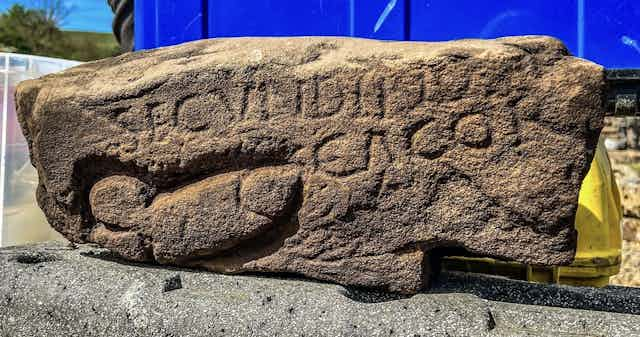The fort of Vindolanda, on the Hadrianic frontier (south of Hadrian’s wall), now in northern England, is an internationally famous site, which was occupied by Romans between 85 AD and 370 AD. Long-term excavations here, supported by volunteers, regularly produce new and amazing discoveries.
As well as uncovering new parts of the fort and civilian settlement, the discoveries occasionally make headlines. Last year, a new sandstone relief carving was discovered and in recent years a temple to the god Jupiter-Dolichenus and the curious case of a skeleton of a child who was probably murdered found under a third-century barrack floor. Excavations in 2022 have reported the discovery of a new phallic carving, complete with a crude insult carved into it.
Next to a relief carving of a penis, is the phrase SECVNDIVS CACOR – “Secundius, the shitter”. The media coverage of this discovery has focused on the use of ancient swearing. But, in my opinion, this is not the most interesting thing about it.
Phallic Britain
Phallic carvings were commonplace in the ancient world. My PhD research identified at least 92 from Roman Britain and the archaeologist Rob Collins’ 2020 investigation into phallusses on the Hadrianic frontier identified 13 from Vindolanda itself, giving the site the greatest density of phallic carvings anywhere in the province.

These sorts of carvings were usually found in boundaries and transitional spaces, such as walls, gateways, windows and doors. In the Roman psyche, these spaces were particularly at risk from supernatural dangers because meeting and crossing places are where people naturally interacted. The malignant forces of the Evil Eye were thought to be particularly powerful there. The Evil Eye is an ancient embodiment of bad luck and inauspicious circumstances and was depicted as a large, unblinking human eye in carvings, mosaics and art across the Roman Empire.
Despite the long history of redevelopment and change at Roman Vindolanda, some of the existing carvings there remain in their original spaces, notably a stylised phallic carving on the floor inside a building and a carving that was part of a fallen wall, which was originally displayed on it. Likely, the newly discovered phallic carving was also in such a space and so was intended to protect somewhere from supernatural dangers.
A new carving
The new carving is unusual for several reasons. For one, the combination of a phallic carving and an inscription is rare. There are eight other examples from Roman Britain and, of these, only four survive as legible phrases. One from Adel (now Leeds) reads PRIMNUS MINTLA “Primnus, his phallic charm” and another from Maryport in west Cumberland is inscribed VERPAM SEPT “The phallus of Marcus Septimius”. Both of these claim ownership over the power of the phallic carving.
One at Vindolanda, which had been used as a drain cover, was inscribed H P III (Habet pedes III) “it is three feet long”. It’s unclear whether this is identifying something to do with the drain or it’s a humorous boast about the size of the owner’s phallus. If the latter, it might be in the same category of bawdy inscription as the recent discovery.

The media coverage of the new carving focused on it being “rude and crude” or “hilarious”. Text like this, written on a stone, is part of a wider tradition of public graffiti in the Roman world. Perhaps calling Secundius a shitter was meant to be funny. There are links to laughter being a way to dispel the effects of the Evil Eye. Perhaps the inscription acted as a sort of curse, invoking Secundius to gastrointestinal illness? Or a humiliating announcement of an existing bout of diarrhoea?
That the phallus is pointing towards the inscription is curious. It’s possible that it was intended to be ejaculating towards or over the second carved word. That might seem particularly crude, but in the ancient world, this was another way that phallic carvings spread their good luck around. So it was an amulet-like image – a sort of charm.
It is possible that it was trying to undo the effects of the graffiti. Stop Secundius from shitting. Or, more likely, in my opinion, the inscription came later and was intended to harness some latent power of this protective image – to corrupt it almost, for humour and/or malignant effects.

